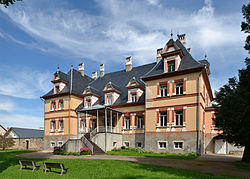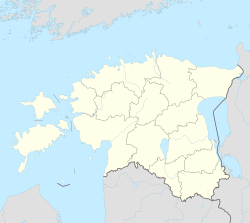Mooste is a small borough in Põlva Parish, Põlva County, Estonia.
Mooste | |
|---|---|
 Mooste manor | |
| Coordinates: 58°09′43″N 27°11′45″E / 58.16194°N 27.19583°E | |
| Country | Estonia |
| County | Põlva County |
| Municipality | Põlva Parish |
Mooste manor
editMooste (German: Moisekatz) estate has a long history, with the first written records dating from 1561. During that time, it belonged to a local member of the Baltic nobility, and stayed in the hands of various noble families for the next 121 years. In 1682, during the time of Swedish rule in Estonia, the estate was, however, expropriated during one of the so-called reductions and became state property. Following the Great Northern War, it thus befell the new, Russian government, and was given by Peter the Great to Count Pavel Yaguzhinsky. Later, however, it appears once more as the property of various Baltic German families. Following the Estonian Declaration of Independence in 1919 and the ensuing far-reaching land reform, the manor became state property. Today it houses a school.[1]
Although the estate dates from the 16th century, the current main building is considerably later, dating from sometime between 1900 and 1910 and designed by Riga-based architect August Reinberg in so-called Heimat-style. The interior still boasts typical details such as decorated cocklestoves, wainscoting and coffered ceilings. In addition to the main building, several well-preserved and large outbuildings make up an unusually grand manor house ensemble.[2][3]
See also
editReferences
edit- ^ Sakk, Ivar (2004). Estonian Manors - A Travelogue. Tallinn: Sakk & Sakk OÜ. p. 229. ISBN 9949-10-117-4.
- ^ Sakk, Ivar (2004). Estonian Manors - A Travelogue. Tallinn: Sakk & Sakk OÜ. p. 229. ISBN 9949-10-117-4.
- ^ Viirand, Tiiu (2004). Estonia. Cultural Tourism. Kunst Publishers. p. 141. ISBN 9949-407-18-4.
External links
edit- Media related to Mooste Manor at Wikimedia Commons
